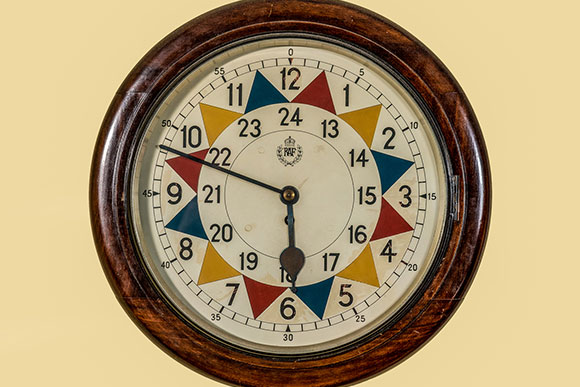Elliott or Smith, C1940
Dimensions: 40cm diameter
Materials: Wood and brass
To listen to the audio description of this object either click the object audio MP3 file below which will play it in your default audio player, or press the play button which you will find after the object audio MP3 file and this will play it from within the web page. The play button can also be used to pause the audio. This button is followed by the elapsed and remaining time, and a further button to mute the audio.
Operations Room Clock Audio MP3 File
This is an original Operations Room clock which would have hung at RAF Bentley Priory.
The clock has a round face and is around 40cm in diameter. It has a rounded dark wooden casing around the face and a large wooden box at the back containing the clock mechanism. The face is white with a glass front and the numbers and hands are black.
The most interesting and iconic feature of the clock is the coloured triangular markers which run in a circle below the numbers, 1 to 12. The triangles point up between each of the numbers in five minute intervals and are coloured alternately in red, yellow and blue. Below the circle of triangles is the 24 hour clock, labelled 13 to 24.
The clock was an important feature of the ‘Dowding System’, an innovative air defence system that was developed at RAF Bentley Priory in the late 1930s, and proved to be critical during the Battle of Britain in 1940.
The Dowding System used information about incoming enemy raids from newly developed radar technology and the Observer Corps. Information received from the radar stations was filtered in the Filter Room at RAF Bentley Priory and then passed on to the Operations Room once it was confirmed as an enemy raid. The Operations Room Clock was essential in ensuring that the information on incoming aircraft raids remained current. The direction of these raids was plotted onto the map using coloured arrows. The colour corresponded to the time of arrival of the information depending on which coloured segment the minute hand fell. Once the minute hand moved into a new colour, all the old arrows in that colour were removed in order to repeat the process and to ensure that information was never more than 15 minutes old.
The information was passed from Headquarters Fighter Command at RAF Bentley Priory to relevant regional headquarters, known as Group Headquarters, who passed it onto Operations Rooms at Sector level. It was the Operations Rooms at Sector level who issued the orders to Fighter Airfields for squadrons to scramble to intercept enemy raids – thus ensuring time and fuel were not wasted patrolling the skies.
 What’s On
What’s On Opening Hours & Admission
Opening Hours & Admission

